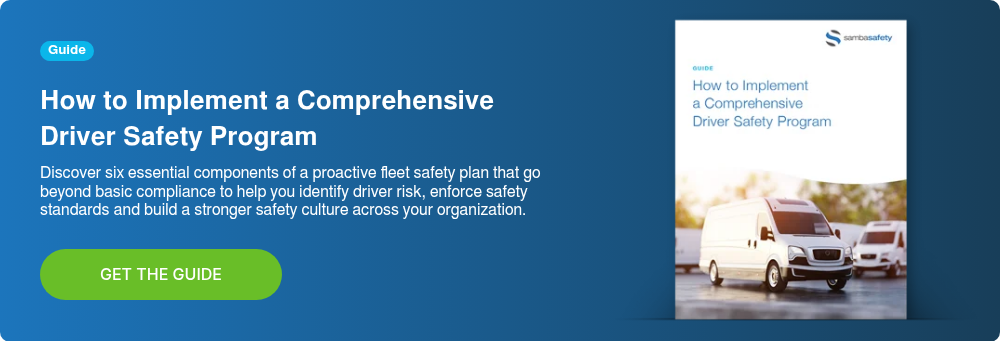
The Federal Motor Carrier Safety Administration’s (FMCSA) safety regulations play a pivotal role in ensuring the safety of commercial motor vehicles (CMVs) on American roadways. Understanding and adhering to these regulations is both a legal obligation and a fundamental responsibility for fleet managers and operators. By upholding these regulations, the CMV industry can contribute significantly to reducing crashes and enhancing road safety for all.
In this blog, we explore critical FMCSA safety regulations that support fleet safety, covering topics such as Hours of Service, drug and alcohol testing, driver vehicle inspection reports, the CSA program and more. By the end of this article, you’ll have a thorough understanding of these regulations and their significance in ensuring road safety.
What is the FMCSA?
Before we dive into the regulations, let’s first understand the role of the FMCSA. This agency, a part of the U.S. Department of Transportation (DOT), is entrusted with the responsibility of regulating the CMV industry. Its primary mission is to safeguard America’s roadways by reducing crashes, injuries and fatalities involving CMVs. The FMCSA achieves this by issuing and enforcing rules and regulations that govern CMV operators.
The FMCSA employs a meticulous process for creating and enforcing its regulations. These rules are formulated based on extensive nationwide crash and safety data. Collaboration with CMV companies is also a fundamental aspect of this process, as it seeks to strike a balance between federal regulations and concerns about operational efficiency and privacy.
Regulatory changes often involve hearings with industry leaders to adapt and update policies. Once established, FMCSA regulations are officially published in the Federal Register and incorporated into the U.S. Code of Federal Regulations. To ensure compliance, these regulations are enforced through cooperation with federal and state law enforcement agencies.
Who Must Follow FMCSA Regulations?
It’s essential to recognize that all CMV operators, encompassing both large fleets and small businesses, fall under the purview of FMCSA regulations. This extends beyond trucking companies to include bus companies, construction firms and any business operating commercial vehicles or employing drivers who hold a commercial driver’s license (CDL). The specific regulations to be followed depend on factors such as the type of vehicles operated, transported goods and travel distances.
Key FMCSA Safety Regulations
Now, let’s explore some of the critical FMCSA safety regulations that are integral to fleet safety.
Compliance, Safety and Accountability (CSA) Program
The CSA program is an initiative aimed at identifying high-risk carriers with safety issues and prioritizing them for interventions. Fleet managers must comprehend how CSA scores work, as these scores are based on safety events and percentile ranks assigned to carriers. The program covers seven Behavior Analysis and Safety Improvement Categories (BASICs), each focusing on specific aspects of safety, from unsafe driving to hazardous materials compliance. Maintaining low CSA scores is crucial, as it can result in lower insurance premiums, fewer audits and an improved reputation with customers.
Pre-Employment Checks
Before hiring a new CDL driver, FMCSA regulations require employers to conduct comprehensive pre-employment background checks. These checks encompass examining motor vehicle records, investigating safety history and crash records, verifying substance abuse history and conducting pre-employment drug tests. Importantly, drug testing is an ongoing requirement, as anyone operating a motor vehicle for work can be subjected to random drug or alcohol testing.
Drug and Alcohol Testing
Since the early 1990s, the FMCSA has mandated drug and alcohol testing for employees driving commercial trucks and buses requiring a CDL. These regulations determine who must be tested, when testing should occur and the procedures for return to safety-sensitive duties after a violation. Privacy protections are also in place to safeguard sensitive medical information. In late 2019, the FMCSA introduced the Drug and Alcohol Clearinghouse, an online database for recording test results and ensuring compliance.
Annual MVR Checks
Companies employing CDL drivers must also conduct an annual review of their drivers’ MVRs. This requirement is in place to ensure that carriers confirm their drivers’ compliance with FMCSA’s essential safety criteria.
Under these regulations, carriers are obligated to maintain an up-to-date MVR for each driver within their Driver Qualification file. The carrier’s responsibility includes requesting and reviewing each driver’s MVR every 12 months, with records to be retained for a period of three years. During this process, carriers must carefully examine the MVRs of their employed drivers to ascertain whether they meet the minimum safety standards for operating a CMV.
Annual MVR reviews serve as a crucial mechanism to verify that CMV drivers have not incurred any disqualifications listed in 49 CFR Part 391.15. It acts as a safeguard to ensure that drivers continue to meet the necessary standards for safe driving within the context of commercial motor vehicles.
Regardless of whether it is mandated by law, conducting ongoing checks of the MVRs of all employees who operate vehicles for work is considered a prudent and responsible business practice.
Find Out Why Relying on an Annual MVR Review is Risky Business
Vehicle Inspections
CMV drivers are obligated to complete vehicle inspections daily, both before and after operating the vehicle. Driver vehicle inspection reports (DVIRs) are crucial for fleet compliance. If a safety issue is identified during a DOT inspection, the vehicle must undergo repairs before returning to the road. DVIRs encompass a range of vehicle components, from brakes and lights to tires and steering mechanisms, and serve as a vital safeguard against safety issues.
Hours of Service (HOS)
HOS regulations, designed to combat driver fatigue, specify the maximum consecutive hours a commercial truck driver or other CMV operator can drive or work before taking a mandatory rest break. These regulations underwent significant changes with the Electronic Logging Device (ELD) mandate, which came into effect in December 2017. ELDs, or electronic logbooks, automatically record driving time, replacing paper logs.
Adherence to HOS regulations is of utmost importance, as violations can adversely affect a carrier’s safety rating and lead to out-of-service penalties.
Hazardous Materials (HazMat)
FMCSA regulations dictate that only registered entities can ship or receive hazardous materials in the United States. All hazardous materials must be classified, described and packaged in accordance with specific FMCSA hazardous materials (HazMat) regulations. Violations of HazMat regulations can result in civil and criminal penalties. Moreover, employees handling hazardous materials must receive adequate training, with employers bearing the responsibility of ensuring compliance with FMCSA standards.
Cargo Securement
Proper cargo securement is another fundamental requirement outlined in FMCSA safety regulations. This entails securely fastening tie-downs, using chocks and wedges to prevent movement and ensuring the correct number of tie-downs based on weight requirements. Loads must not obstruct the driver’s view, and packaging issues must be addressed. Moreover, elements like tailgates, doors and spare tires must be securely attached to prevent dislodgement during transport.
Record Keeping
Compliance with DOT and FMCSA regulations involves maintaining an extensive array of records. These records include proof of insurance, motor vehicle reports, drug testing records, driver rosters, service provider contracts, HOS records, vehicle inspection reports, employee training records, incident and crash reports and quarterly IFTA reports. The duration for which records must be retained varies by record type, and it is incumbent upon employers to ensure their proper maintenance and accessibility in the event of a DOT audit.
Discover New Strategies for Improving Your CSA Score
To learn how you can elevate your approach to ensuring fleet safety and FMCSA compliance, download our free guide, How to Implement a Comprehensive Driver Safety Program.




